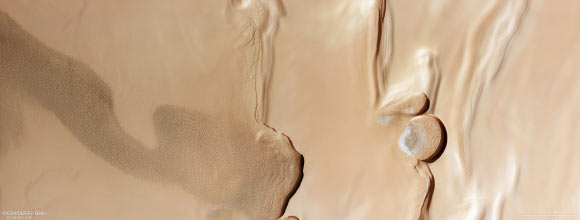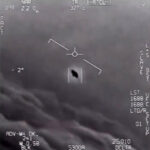New images from the High Resolution Stereo Camera (HRSC) on ESA’s Mars Express spacecraft show the terrain surrounding the permanent north polar ice cap of Mars.
This image from ESA’s Mars Express shows an area close to Mars’ north pole. The image comprises data gathered by Mars Express’ High Resolution Stereo Camera (HRSC) on April 14, 2023. Image credit: ESA / DLR / FU Berlin.
Mars’ permanent north polar ice cap is a stack of water ice and dust layers up to 3 km thick and approximately 1,000 km in diameter.
These are divided into four stacked ‘packets’ of different thicknesses, which in turn are made up of finer layers.
These layers contain information about the climate dating back several million years in the history of Mars.
The deposits were formed by atmospheric precipitation of dust and water ice and by direct frost formation.
They consist mainly of water ice, with fine dust sediments making up between 10 and 15% of the total.
They probably reflect changes in the orbit of Mars and the inclination of the planet’s axis of rotation, whose orientation is much more unstable than that of the Earth.
It varies in several cycles with periods ranging from a few thousand to a few million years.
The varying solar radiation results in a strongly varying climate, especially at the poles. It is assumed that the north polar ice cap is currently growing.
“The terrain surrounding Mars’ north pole, known as Planum Boreum, is fascinating,” said members of the Mars Express team.
“The pole itself is covered in layers and layers of fine dust and water ice; these stack several km thick and stretch out for around 1,000 km.”
“While most of this material is not visible here, you can see the beginnings of Planum Boreum to the right of the frame, with some subtle wrinkling showing where layers of material are starting to build up.”
“Ground has also built up more starkly in steps, as is most clearly visible in the topographic view of this region below.”
“The lowest altitude regions are blue/green and the highest are red/white/brown.”
“These layers formed as a mix of dust, water ice and frost settled on the Martian ground over time.”
“Each layer holds valuable information about Mars’ history, telling the story of how the planet’s climate has changed over the past few million years.”
“In Martian winter, the layers are topped by a thin cap of carbon dioxide ice a couple of meters thick. This cap completely disappears to the atmosphere each Martian summer.”
The left part of the image is dominated by a vast, elongated swathe of rippled sand dunes, stretching out for more than 150 km within this frame alone.
This wrinkled, turbulent appearance is highly at odds with the smooth and more pristine terrain visible to the right.
This smooth region lacks clear signs of erosion and has avoided being hit by incoming rocks from space — an indicator that the surface is very young, likely rejuvenating every year.
“Between these two extremes sit two semicircular cliffs, the larger of which is around 20 km wide,” the researchers said.
“Within the curves of these cliffs sit frost-covered sand dunes.”
“The grand scale of the cliffs is clear from the dark shadows they cast on the surface below — their steep, icy walls tower up to a kilometer high.”
“These two cliffs are located at a so-called polar trough, a feature created as wind pushes into and wears away the surface.”
“These show up as rippled ridges in the terrain and are common in this region, creating the distinctive spiral-like pattern of the polar plateau.”




